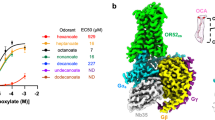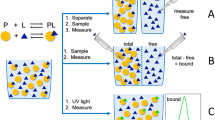Abstract
Native porcine odorant-binding protein (OBP) bears eleven sites of phosphorylation, which are not always occupied in the molecular population, suggesting that different isoforms could co-exist in animal tissues. As phosphorylation is a dynamic process resulting in temporary conformational changes that regulate the function of target proteins, we investigated the possibility that OBP isoforms could display different binding affinities to biologically relevant ligands. The availability of recombinant proteins is of particular interest for the study of protein/ligand structure-function relationships, but prokaryotic expression systems do not perform eukaryotic post-translational modifications. To investigate the role of phosphorylation in the binding capacities of OBP isoforms, we produced recombinant porcine OBP in two eukaryotic systems, the yeast, Pichia pastoris, and the mammalian CHO cell line. Isoforms were separated by anion exchange HPLC, and their phosphorylation sites were mapped by MALDI-TOF mass spectrometry and compared to those of the native protein. Binding experiments with ligands of biological relevance in the pig, Sus scrofa, were performed by fluorescence spectroscopy on two isoforms of recombinant OBP expressed in the yeast. The two isoforms, differing only by their phosphorylation pattern, displayed different binding properties, suggesting that binding specificity is driven by phosphorylation.






Similar content being viewed by others
References
Brennan, P. A., and Kendrick, K. M. 2006. Mammalian social odours: attraction and individual recognition. Philos. Trans. R. Soc. Lond. B Biol. Sci. 361:2061–2078.
Briand, L., Nespoulous, C., Perez, V., Rémy, J.-J., Huet, J.-C., and Pernollet, J.-C. 2000. Ligand-binding properties and structural characterization of a novel rat odorant-binding protein variant. Eur. J. Biochem. 267: 3079–3089.
Buck, L. 2004. Olfactory receptors and odor coding in mammals. Nutr. Rev. 62:S184–188 & S224–241.
Burova, T. V., Choiset, C. K., Jankowski, T., and Haertle, T. 1999. Conformational stability and binding properties of porcine odorant binding protein. Biochemistry 38:15043–15051.
Daly, R. and Hearn, M. T. W. 2005. Expression of heterologous proteins in Pichia pastoris: a useful experimental tool in protein engineering and production. J. Mol. Recognit. 18:119–138.
Dorries, K. M., Adkins-Reagan, E., and Halpern, B. P. 1995. Olfactory sensitivity to the pheromone, androstenone, is sexually dimporphic in the pig. Physiol. Behav. 57:255–259.
Golebiowski, J., Antonczak, S., and Cabrol-Bass, D. 2006. Molecular dynamics studies of odorant binding protein free of ligand and complexed to pyrazine and octenol. J. Mol. Struct. (Theochem) 763:165–174.
Golebiowski, J., Antonczak, S., Fiorucci, S., and Cabrol-Bass, D. 2007. Mechanistic events underlying odorant binding protein chemoreception. Proteins 67:448–458.
Guiraudie, G., Pageat, P., Cain, A.-H., Madec, I., and Nagnan-Le Meillour, P. 2003. Functional characterization of olfactory binding proteins for appeasing compounds and molecular cloning in the vomeronasal organ of pre-pubertal pigs. Chem. Senses 28:609–619.
Katkov, T., Booth, W. D., and Gower, D. B. 1972. The metabolism of 16-androstenes in boar salivary glands. Biochim. Biophys. Acta 270:546–556.
Kato, A. and Touhara, K. 2009. Mammalian olfactory receptors: pharmacology, G protein coupling and desensitization. Cell. Mol. Life Sci. 66:3743–3753.
Ko, H. J. and Park, T. H. 2008. Enhancement of odorant detection sensitivity by the expression of odorant-binding protein. Biosens. Bioelectron. 23:1017–1023.
Ko, H. J., Lee, S. H., Oh, E. H., and Park, T. H. 2010. Specificity of odorant-binding proteins: a factor influencing the sensitivity of olfactory receptor-based biosensors. Bioprocess Biosyst. Eng. 33:55–62.
Lakowitz, J. R. 1999. Principles of Fluorescence Spectroscopy. 2nd edition. Kluwer Academic/Plenum, New York.
Le Danvic, C., Guiraudie-Capraz, G., Abderrahmani, D., Zanetta, J.-P., and Nagnan-Le Meillour, P. 2009. Natural ligands of porcine olfactory binding proteins. J. Chem. Ecol. 35:741–751.
Loëbel, D., Marchese, S., Krieger, J., Pelosi, P., and Breer, H. 1998. Sub-types of odorant-binding proteins-Heterologous expression and ligand binding. Eur. J. Biochem. 254:318–324.
Mann, M., Ong, S. E., Gronborg, M., Steen, H., Jensen, O. N., and Pandey, A. 2002. Analysis of protein phosphorylation using mass spectrometry: deciphering the phosphoproteome. Trends Biotechnol. 20:261–268.
McGlone, J. J. 1985. Olfactory cues and pig agonistic behavior: evidence for a submissive pheromone. Physiol. Behav. 34:195–198.
McGlone, J. J. and Morrow, J. L. 1988. Reduction of pig agonistic behavior by androstenone. J. Anim. Sci. 66:880–884.
McGlone, J. J., and Anderson, D. L. 2002. Synthetic maternal pheromone stimulates feeding behavior and weight gain in weaned pigs. J. Anim. Sci. 80:3179–3183.
McKerell, A. D. Jr., Bashford, D., Bellott, R. L., Dunbrack, R. L. JR., Evanseck, J. D., Field, M. J., Fischer, S., Gao, J., Guo, H., Ha, S., Joseph-McCarthy, D., Kuchnir, L., Kuczera, K., Lau, F. T. K., Mattos, C., Michnick, S., Ngo, T., Nguyen, D. T., Prodhom, B., Reiher, W. E. III, Roux, B., Schlenkrich, M., Smith, J.-C., Stote, R., Straub, J., Watanabe, M., Wiorkiewicz-Kuczera, J., Yin, D., and Karplus, M. 1998. All-atom empirical potential for molecular modelling and dynamics studies of proteins. J. Phys. Chem. B 102:3586.
Nagnan-Le Meillour, P., Lagant, P., Cornard, J.-P., Brimau, F., Le Danvic, C., Vergoten, G., and Michalski, J.-C. 2009a. Phenylalanine 35 and tyrosine 82 are involved in the uptake and release of ligand by porcine odorant-binding protein. Biochim. Biophys. Acta 1794:1142–1150.
Nagnan-Le Meillour, P., Le Danvic, C., Brimau, F., Chemineau, P., and Michalski, J.-C. 2009b. Phosphorylation of native porcine olfactory binding proteins. J. Chem. Ecol. 35:752–760.
Narhi, L. O., Arakawa, T., Aoki, K. H., Elmore, R., Rohde, M. F., Boone, T., and Strickland, T. W. 1991. The effect of carbohydrate on the structure and stability of erythropoietin. J. Biol. Chem. 266:23022–23026.
Nath, D., Maiti, A., and Majumder, G. C. 2008. Cell surface phosphorylation by a novel ecto-protein kinase: a key regulator of cellular functions in spermatozoa. Biochim. Biophys. Acta 1778:153–165.
Paolini, S., Tanfani, F., Fini, C., Bertoli, E., and Pelosi, P. 1999. Porcine odorant-binding protein: structural stability and ligand affinities measured by Fourier-transform infrared spectroscopy and fluorescence spectroscopy. Biochim. Biophys. Acta 1431:179–188.
Parisi, M., Mazzini, A., Tibor Sorbi, R., Ramoni, R., Grolli, S., and Favilla, R. 2005. Role of the disulfide bridge in folding, stability and function of porcine odorant binding protein: Spectroscopic equilibrium studies on C63A/C155A double mutant. Biochim. Biophys. Acta 1750:30–39.
Pelosi, P. 1996. Perireceptor events in olfaction. J. Neurobiol. 30:3–19.
Pelosi, P. 2001. The role of perireceptor events in vertebrate olfaction. Cell. Mol. Life Sci. 58:503–509.
Pelosi, P., Baldaccini, N. E., and Pisanelli, A. M. 1982. Identification of a specific olfactory receptor for 2-isobutyl-3 methoxypyrazine. Biochem. J. 201:245–248.
Spinelli, S., Ramoni, R., Grolli, S., Bonicel, J., Cambillau, C., and Tegoni, M. 1998. The structure of the monomeric porcine odorant binding protein sheds light on the domain swapping mechanism. Biochemistry 37:7913–7918.
Tcatchoff, L., Nespoulous, C., Pernollet, J.-C., and Briand, L. 2006. A single lysyl residue defines the binding specificity of human odorant-binding protein for aldehydes. FEBS Lett. 580:2102–2108.
Tirindelli, R., Dibattista, M., Pifferi, S., and Menini, A. 2009. From pheromones to behavior. Physiol. Rev. 89:921–956.
Vidic, J., Grosclaude, J., Monnerie, R., Persuy, M. A., Badonnel, K., Baly, C., Caillol, M., Briant, L., Salesse, R., and Pajot-Augy, E. 2008. On a chip demonstration of a functional role for odorant binding protein in the preservation of olfactory receptor activity at high odorant concentration. Lab. Chip 8:678–688.
Vincent, F., Spinelli, S., Ramoni, R., Grolli, S., Pelosi, P., Cambillau, C., and Tegoni, M. 2000. Complexes of odorant binding protein with odorant molecules belonging to different chemical classes. J. Mol. Biol. 300:127–139.
Wei, Y., Brandazza, A., and Pelosi, P. 2008. Binding of polycyclic aromatic hydrocarbons to mutants of odorant-binding protein: a first step towards biosensors for environmental monitoring. Biochim. Biophys. Acta 1784:666–671.
Acknowledgments
The authors thank the University of Lille1 (USTL), the French INRA (Institut National de la Recherche Agronomique), and CNRS (Centre National de la Recherche Scientifique) for funding.
Author information
Authors and Affiliations
Corresponding author
Electronic supplementary material
Below is the link to the electronic supplementary material.
Supplemental Data Fig. S1
Monoisotopic mass spectra of MALDI-TOF MS analysis of carboxymethylated band (SDS-PAGE) containing OBP-Pichia-iso2 after Beta-Elimination followed by Michael Addition of Dithiothreitol (BEMAD, DTT) with T+CT treatment. a) Peptide elution with acetonitrile 25% and b) Peptide elution with acetonitrile 50%. (GIF 123 kb)
Supplemental Data Fig. S2
Monoisotopic mass spectra of MALDI-TOF MS analysis of carboxymethylated band (SDS-PAGE) containing OBP-Pichia-iso2 after Beta-Elimination followed by Michael Addition of Dithiothreitol (BEMAD, DTT) with CT treatment. Peptide elution with acetonitrile 50%. (GIF 116 kb)
Supplemental Data Fig. S3
Monoisotopic mass spectrum of MALDI-TOF MS analysis of carboxymethylated band (SDS-PAGE) containing OBP-Pichia-iso2 after Beta-Elimination followed by Michael Addition of Dithiothreitol (BEMAD, DTT) with T treatment. a) Peptide elution with acetonitrile 25% and b) Peptide elution with acetonitrile 50%. (GIF 130 kb)
Supplemental Data Fig. S4
Monoisotopic mass spectra of MALDI-TOF MS analysis of carboxymethylated band (SDS-PAGE) containing OBP-Pichia-iso3 after Beta-Elimination followed by Michael Addition of Dithiothreitol (BEMAD, DTT)with T+CT treatment. a) Peptide elution with acetonitrile 25% and b) Peptide elution with acetonitrile 50%. (GIF 106 kb)
Supplemental Data Fig. S5
Monoisotopic mass spectra of MALDI-TOF MS analysis of carboxymethylated band (SDS-PAGE) containing OBP-Pichia-iso3 after Beta-Elimination followed by Michael Addition of Dithiothreitol (BEMAD, DTT) with CT treatment. a) Peptide elution with acetonitrile 25% and b) Peptide elution with acetonitrile 50%. (GIF 133 kb)
Supplemental Data Fig. S6
Monoisotopic mass spectrum of MALDI-TOF MS analysis of carboxymethylated band (SDS-PAGE) containing OBP-Pichia-iso3 after Beta-Elimination followed by Michael Addition of Dithiothreitol (BEMAD, DTT) with T treatment. Peptides elution with acetonitrile 50%.) (GIF 82 kb)
Rights and permissions
About this article
Cite this article
Brimau, F., Cornard, JP., Le Danvic, C. et al. Binding Specificity of Recombinant Odorant-Binding Protein Isoforms is Driven by Phosphorylation. J Chem Ecol 36, 801–813 (2010). https://doi.org/10.1007/s10886-010-9820-4
Received:
Revised:
Accepted:
Published:
Issue Date:
DOI: https://doi.org/10.1007/s10886-010-9820-4
Key Words
- Anion exchange HPLC
- Fluorescence spectroscopy
- Heterologous expression
- Matrix assisted laser desorption/ionization-time of flight (MALDI-TOF) mass spectrometry
- Odorant-binding protein
- Peptide mapping
- Pheromone
- Phosphorylation
- Polymerase chain reaction (PCR)
- Recombinant protein
- Sodium dodecyl sulfate-polyacrylamide gel electrophoresis (SDS-PAGE)
- Sus scrofa
- Western blotting




